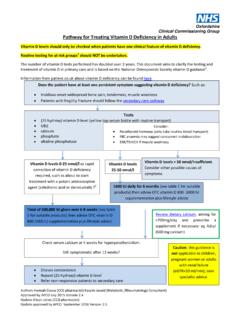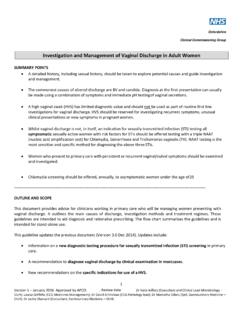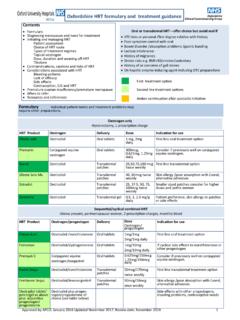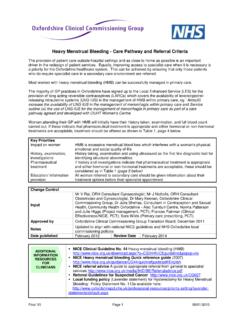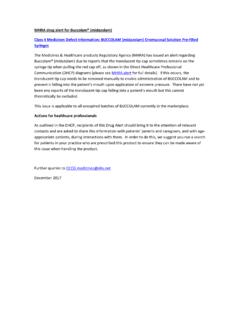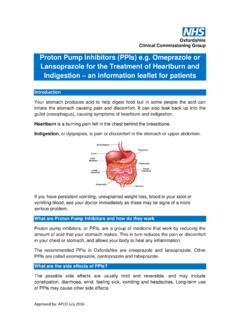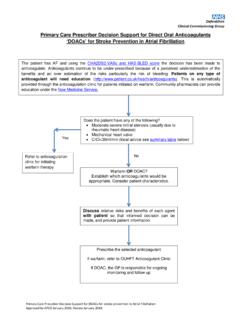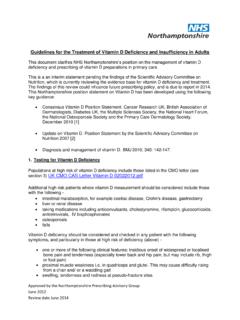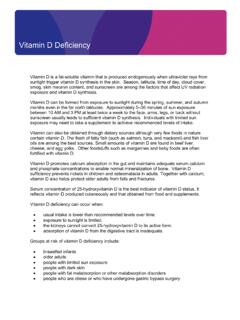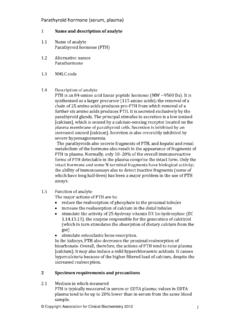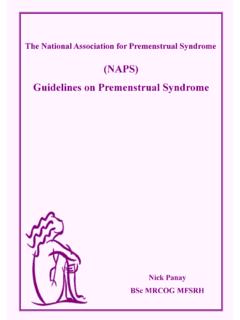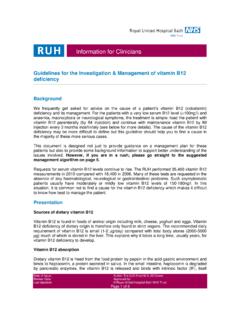Transcription of Vitamin D supplementation in pregnancy - NHS …
1 Vitamin D supplementation in pregnancy Guideline 1. Approved by APCO September 2017. Review September 2019 Page 1 of 14 Author: Lucy Mackillop, Obstetric Physician, OUH Maternity Department Vitamin D supplementation in pregnancy Document Information Document Type: Guideline Valid From: 28/04/2016 Date of Review: 28/04/2019 Appraisal Score: Domain 1 2 3 4 5 Overall Score (%) 92 86 88 92 92 89% Ratification Date & Body: 28/04/2016, Women s Clinical Governance Committee Document Author(s): Obstetric Physician Development Group Member(s): Obstetric Physician Team Clinical Lead: Obstetric Physician Associated OUH Documents: N/A Document Replaces: Vitamin D supplementation in pregnancy , , 04/05/2017 Equality Impact Assessment: 04/01/2016 Vitamin D supplementation in pregnancy Guideline 1. Approved by APCO September 2017. Review September 2019 Page 2 of 14 Author: Lucy Mackillop, Obstetric Physician, OUH Maternity Department Contents Document Information.
2 1 Key Recommendations .. 3 Background .. 3 Aims .. 3 Scope .. 4 Definitions .. 4 Executive Summary .. 5 Key aims of Vitamin D supplementation .. 5 Full Guideline .. 6 The importance of screening for Vitamin D sufficiency .. 6 The at risk population (NEW) .. 6 When to test Vitamin D levels (NEW) .. 6 Additional laboratory Key aims of Vitamin D supplementation .. 7 Supplementing Vitamin D based on levels of sufficiency ..7 Definition of Vitamin D Sufficiency (NEW) ..8 Safety of Vitamin D .. 8 Safety of Vitamin D in pregnancy ..8 Safety of Vitamin D in the general population (risk of toxicity) ..8 Monitoring .. 9 Dosing intensity and timing ..9 Special circumstances for Vitamin D supplementation ..9 Vitamin D replacement algorithm in pregnant and breastfeeding women (NEW) .. 10 Post-natal follow up .. 10 Appendix 1 The need for more intensive Vitamin D supplementation in pregnancy .
3 12 Appendix 2 Monitoring and Compliance .. 13 References .. 13 Vitamin D supplementation in pregnancy Guideline 1. Approved by APCO September 2017. Review September 2019 Page 3 of 14 Author: Lucy Mackillop, Obstetric Physician, OUH Maternity Department Key Recommendations Vitamin D supplementation should be discussed with all pregnant and breastfeeding women All pregnant/breastfeeding women should receive at least 400 units/day cholecalciferol from OTC preparations or Healthy Start if eligible. Women should be assessed for their risk of Vitamin D deficiency at their booking appointment. At risk groups for Vitamin D deficiency or insufficiency should be started on 1000 units cholecalciferol daily (Figure 1) Women at moderate or high risk of Vitamin D deficiency should be tested with their booking blood tests.
4 All pregnant women with Vitamin D deficiency should have their Vitamin D replaced according to the level of insufficiency to ensure it is adequately replaced by the third trimester. All babies should have 400 units per day unless fully formula fed. Background There has been increasing awareness of the benefits of Vitamin D supplementation during pregnancy and studies demonstrating current levels of deficiency in the UK population. The National Diet and Nutrition Survey have demonstrated that a quarter of the inhabitants in UK have low Vitamin D levels. In 2012, the UK Health Department identified at risk groups for Vitamin D deficiency, this included pregnant and breastfeeding women, especially teenagers and young women ( Vitamin D advice on supplements for at risk groups letter from UK Chief Medical Officers Department of Health ).
5 In June 2014, the RCOG Scientific Impact Paper No. 43 discusses the benefits of Vitamin D in pregnancy . The NICE public health guidance 56 (Nov 2014) aims to identify and prevent Vitamin D deficiency in at risk populations, which include pregnant and breastfeeding women. Aims To inform clinicians and other practitioners caring for pregnant women about the need for Vitamin D in pregnancy and breastfeeding To recognise the at risk population in need of Vitamin D supplementation To guide the optimal management for Vitamin D supplementation in pregnant and breastfeeding women To enable all pregnant and breastfeeding women to have optimal supplementation of Vitamin D by the third trimester Vitamin D supplementation in pregnancy Guideline 1. Approved by APCO September 2017. Review September 2019 Page 4 of 14 Author: Lucy Mackillop, Obstetric Physician, OUH Maternity Department Scope To incorporate these latest recommendations from NICE and RCOG to improve the care of pregnant and breastfeeding women within the Oxford University Hospitals NHS Foundation Trust, by raising the awareness of Health Care Professionals within the Maternity Services.
6 Definitions Term Definition CKD Chronic kidney disease TB Tuberculosis MMRA Maternal Medicine Risk Assessment OTC Over the counter PET Pre-eclampsia Vitamin D supplementation in pregnancy Guideline 1. Approved by APCO September 2017. Review September 2019 Page 5 of 14 Author: Lucy Mackillop, Obstetric Physician, OUH Maternity Department Executive Summary Around 20% of adults in the United Kingdom have low Vitamin D levels because of the lack of ambient sunlight and other extenuating risk factors. Rickets has now re-emerged, within the UK. At risk populations are likely to have low Vitamin D levels, so their infants are also likely to be born with low Vitamin D stores that are further depleted by the lack of Vitamin D in maternal breastmilk. These children are at high risk of childhood rickets. Key aims of Vitamin D supplementation To ensure: 1.
7 Maternal Vitamin D levels are replete to avoid neonatal rickets. 2. Vitamin D deficiency is reversed in a timely manner. 3. Avoid (or reverse) the consequences of Vitamin D deficiency. How to deliver excellent care How to document that care All women should be assessed for Vitamin D sufficiency at booking or when there is any contact with antenatal care. To fill the MMRA or EPR booking form for risk assessment of Vitamin D status. This should be documented in the EPR record or the antenatal notes. All pregnant and breastfeeding women should have at least 400 units (10mcg) cholecalciferol a day. Antenatal vitamins should be included in the medications history of the antenatal notes. Women who belong to the at risk group should have a higher dose of Vitamin D supplementation . Non-white skin Obese BMI 30 kg/m2 Housebound women or who remain covered Women with delivery date in November to March At risk of pre-eclampsia Recommendations for OTC cholecalciferol 1,000 units daily and be documented in the antenatal notes.
8 Women with high risk conditions should have their Vitamin D levels quantified and adequately replaced. Possible osteomalacia (bone pain, insufficiency or fragility fractures or proximal muscle weakness) Known previous Vitamin D deficiency Multiple sclerosis Malabsorption due to inflammatory bowel disease, gluten enteropathy, gastric surgery, biliary disease, or intestinal overgrowth. Inflammatory rheumatic diseases. Drugs that impair Vitamin D steroids, antacids, antiepileptics, tacrolimus, rifampicin, anti-retrovirals, cholestyramine, diuretics Vitamin D levels should be documented and replacement commenced according to the guideline. (see flowchart) Levels should be rechecked if indicated. Women with CKD 3-5, hyperparathyroidism, granulomatous disease ( sarcoidosis and TB) should be referred to Silver Star or Obstetric Medicine. Referral letter along with Vitamin D levels and current supplementation should be included in the woman s antenatal notes.
9 Vitamin D supplementation in pregnancy Guideline 1. Approved by APCO September 2017. Review September 2019 Page 6 of 14 Author: Lucy Mackillop, Obstetric Physician, OUH Maternity Department After delivery, all women who are breastfeeding should be risk assessed for Vitamin D sufficiency. All breastfeeding women should be on at least 400 units (10mcg) cholecalciferol at discharge. This should be included in the discharge summary. Full Guideline All pregnant and breastfeeding women will require screening for Vitamin D sufficiency, preferably at the booking visit, to ensure there is adequate time for replacing her Vitamin D by the third trimester. The importance of screening for Vitamin D sufficiency There has been a re-emergence of rickets in the UK and internationally as a result of depleted Vitamin D stores and lack of sunlight exposure.
10 National surveys suggest that around a fifth of adults and 8 to 24% of children may have low Vitamin D status.(2) This is compounded by the lack of ambient sunlight of the appropriate ultraviolet wavelength to facilitate synthesis of Vitamin D on exposed skin between mid-October till April, in the UK. Women belonging to the at risk population are particularly vulnerable. They are likely to have low Vitamin D levels and therefore their infants will be born with low Vitamin D stores that are further exacerbated by the lack of Vitamin D in maternal breastmilk. There is no definitive maternal Vitamin D levels that are directly associated with childhood (or congenital) rickets, but studies have indicated that rickets in children less than 3 years is usually associated with maternal Vitamin D deficiency.
